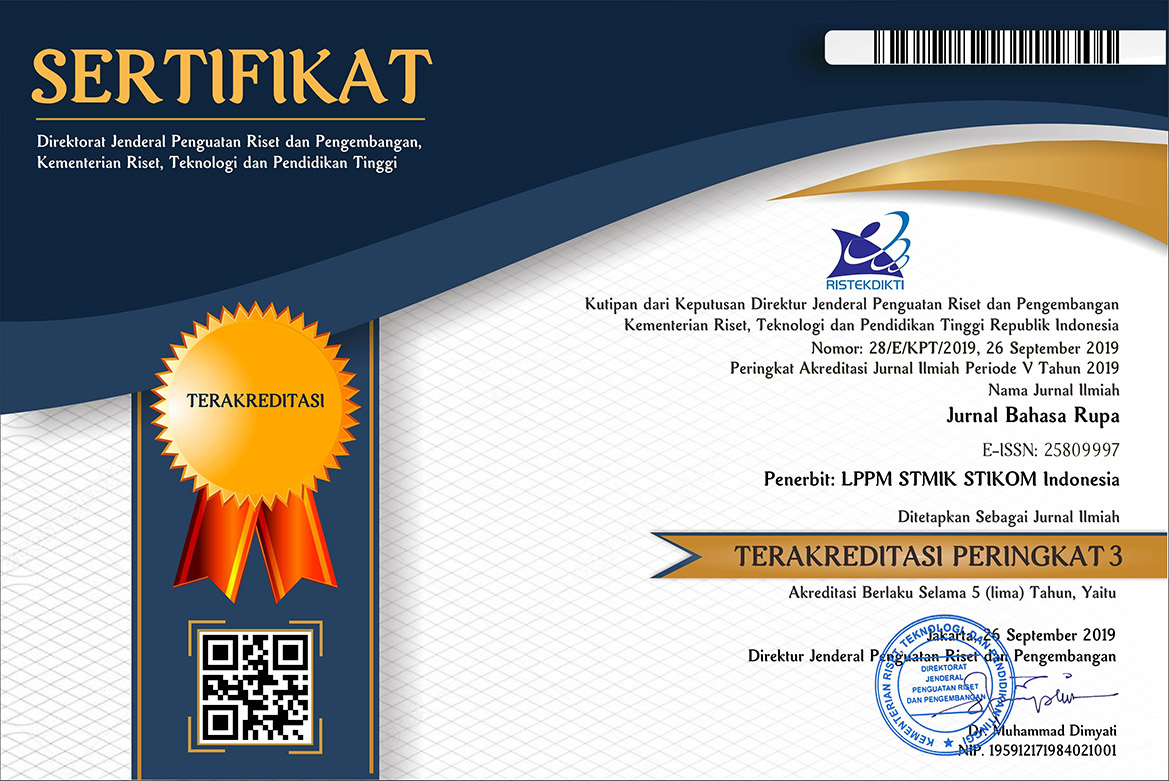GUTTA TAMARIND: MENCIPTAKAN KARYA SENI DENGAN BAHAN RAMAH LINGKUNGAN
DOI:
https://doi.org/10.31598/bahasarupa.v5i2.960Keywords:
alternative, batik, gutta tamarind, painting, silk, waxAbstract
Painting has undergone many developments. One of them is technical development in terms of materials. One of the unique techniques in painting is the gutta tamarind technique which uses ground tamarind seeds that are ground. This study aims to examine the use of tamarind seeds as an alternative medium in the work. Gutta tamarind is popular because the material used resembles the material for batik. However, in the process of using it, gutta tamarind which is also known as cold wax does not require a heating stove like the hot wax of batik in general. In this study, we will discuss the process of making cold wax from tamarind seed powder. This study uses a qualitative descriptive research method by studying the manufacture of cold wax gutta tamarind in stages. The results of this study indicate that the gutta tamarind technique in the process of making textile paintings or wastra paintings produces characters that are no less unique and beautiful.Downloads
References
E. Dwi Ratnasari, “Gutha Tamarin, Si Pengganti Lilin dalam Teknik Batik,” CNN Indonesia, 2017. .
N. Apriani and A. Pandanwangi, “Batik gutta tamarind,” Likupang, 2020.
A. Ariani and A. Pandanwangi, “Eco-friendly batik painting wax made from tamarind seed powder (Tamarindus indica L),” in IOP Conference Series: Earth and Environmental Science, 2021, vol. 737, no. 1, pp. 1–6, doi: 10.1088/1755-1315/737/1/012069.
C. J. Rianingrum, Pelatihan Melukis dengan Media Gutta Tamarind untuk Ibu-ibu di Kawasan bendungan Hilir-Jakarta. Indonesia: Universitas Trisakti, 2020.
R. Mahardika, Y. F. A, and E. D. K, “Pelatihan Batik Lukis Dengan Bubur Biji Asam,” IKRAITH-ABDIMAS, vol. 3, no. 1, pp. 1–7, 2020.
A. Pandanwangi, O. Catherina, and E. Merry, “Pendampingan Komunitas Pembatik Melalui Pelatihan Alih Pengetahuan Membatik dengan Material Berbasis Kearifan Lokal,” Engagem. J. Pengabdi. Kpd. Masy., vol. 3, no. 1, pp. 68–79, 2019, doi: http://dx.doi.org/10.29138/engagement.v3i1.89.
N. Primayanti, “Analisa Pengenalan Metode Batik Dingin Menggunakan Gutha Tamarin Terhadap Apresiasi Budaya Indonesia,” J. Seni Reka Rancang., vol. 2, no. 2, pp. 243–252, 2020.
N. Primayanti and D. Lestari, “Workshop Batik Gutha Tamarin dalam Festival Seni Integreat Fukuoka Jepang,” in Prosiding Seminar Nasional Desain dan Arsitektur (SENADA), 2021, pp. 0–6, doi: 10.1088/1755-1315/737/1/012069.
B. S. Dewi, A. M. Apin, A. Pandanwangi, and N. Damayanti, “Inspirasi Batik Tamarind dari Cerita rakyat,” J. Budaya Nusant., vol. 4, no. April, pp. 269–275, 2021, doi: https://doi.org/10.36456/b.nusantara.vol4.no2.a4056.
A. M. Apin et al., “Batik Tamarin Empowering Woman in Patimban Subang Indonesia,” vol. 07, no. 02, pp. 757–762, 2021.
R. A. Earnshaw, Art, design and technology : collaboration and implementation. United Kingdom: Springer International Publishing AG, 2017.
Y. Zhang and L. Candy, “Investigating collaboration in art and technology,” CoDesign, vol. 2, no. 4, pp. 239–248, Dec. 2006, doi: 10.1080/15710880601008059.
C. Tresnadi and A. Sachari, “Identification of Values of Ornaments in Indonesian Batik in Visual Content of Nitiki Game,” J. Arts Humanit., vol. 4, no. 8, pp. 25–39, 2015, doi: 10.18533/journal.v4i8.797.
J. B. Hochstrasser, “Batik Belanda: Transformed identities cross boundaries in the visual arts (Or: Eliza van Zuylen and creativity at the margins),” Dutch Crossing, vol. 35, no. 2, pp. 148–161, 2011, doi: 10.1179/155909011X13033128278641.
M. S. Koentjoro, “Prosiding SNADES 2020 - Optimisme Desain Untuk Pembangunan Negeri,” in Prosiding SNADES 2020 - Optimisme Desain Untuk Pembangunan Negeri, 2020, pp. 23–29.
J. W. Creswell, Penelitian Kualitatif dan Desain Riset, 3rd ed. Yogyakarta: Pustaka Pelajar, 2014.
S. J. Taylor, R. Bogdan, and M. L. DeVault, Qualitative Reseach Methods, 4th Editio. Canada: John Wiley & Sons, Inc, 2016.
Sumartono, Metodologi Penelitian Kualitatif: Seni Rupa. Universitas Trisakti, 2017.
I. L. Marasabessy, “Pengaruh Penurunan Tarif Pajak Umkm Terhadap Kepatuhan Wajib Pajak Umkm (Studi Kasus Pada Kpp Pratama Pondok Aren),” 2020.
J. Noor, Metodologi Penelitian: Skripsi, Tesis, Disertasi & Karya Ilmiah. Prenada Media, 2016.
C. R. H. Putri, “POTENSI DAN PEMANFAATANTamarindus indicaDALAM BERBAGAI TERAPI,” J. “Ilmiah Kedokteran,” vol. 3, no. 2, pp. 40–54, 2014.
C. Rosyidah, “Uji Dosis Serbuk Biji Asam Jawa (Tamarindus Indica) Sebagai Biokoagulan Terhadap Kualitas Air Ditinjau Dari Aspek Fisik, Kimia, dan Bakteriologi,” Universitas Islam Negeri Malang, 2008.
A. Pandanwangi, “Peran Komunitas Seni Perempuan Dalam Pengembangan Kearifan Lokal,” in Perempuan Indonesia Dulu dan Kini: Membangun Kecerdasan Bangsa di Bumi Nusantara, 1st ed., E. Caturwati, Ed. Bandung: Pustaka Pelajar, 2019.
I. Budiman, “Laporan Wawancara dengan Ibu Belinda Sukapuradewi,” Bandung, 2021.
D. M. M. Luzia and N. Jorge, “Antioxidant Activity, Fatty Acid Profile and Tocopherols of Tamarindus Indica L. Seeds,” Ciência e Tecnol. Aliment., vol. 31, no. 2, pp. 497–501, 2011, doi: 10.1590/s0101-20612011000200034.
H. Hendrawati, D. Syamsumarsih, and N. Nurhasni, “Penggunaan Biji Asam Jawa (Tamarindus indica L.) dan Biji Kecipir (Psophocarpus tetragonolobus L.) Sebagai Koagulan Alami Dalam Perbaikan Kualitas Air Tanah,” J. Kim. Val., vol. 3, no. 1, pp. 22–33, 2013, doi: 10.15408/jkv.v3i1.326.
A. Dewi, E. I. Rustanti, H. Pratiwi, A. T. Nerawati Diana, and Narwati, “Application of tamarindus indica seed extract as bio-coagulant to removal suspended solids and colors,” Int. J. Public Heal. Sci., vol. 10, no. 2, pp. 324–329, 2021, doi: 10.11591/ijphs.v10i2.20686.
A. Pandanwangi, A. M. Apin, B. Sukapura Dewi, N. Damayanti, F. Denianshah, and S. Elnissi., “Adaptasi Pendampingan Teknik Membatik Media Alternatif Baru di Era New Normal,” in Peran Perguruan Tinggi dalam Transformasi, Adaptasi, dan Metamorfosisi Pengabdian pada Masyarakat di Era New Normal, 2020, vol. 5, no. 1, pp. 22–26.
I. Kartiwan, “Workshop Melukis Batik Gutta Tamarind pada Program Pengabdian kepada Masyarakat di Likupang, Manado, Sulawesi Utara,” JabarBicara.com, 2020. .
Redaksi Jabar Bicara, “Pelatihan Melukis Batik Dingin di Kain Menggunakan Media Tamarind pada Anak-anak Pemulung di Bawah Naungan ‘Sekolah BISA,’” JabarBicara.com, Jakarta, 2021.
Anwar Siswadi, “Legenda pada Batik Asam Jawa,” Tempo Newspaper, Jakarta, p. 28, 2018.
A. Pandanwangi, B. S. Dewi, and S. H. Alya, “Visual Literacy of Folklore : Indonesian Batik Style in Gallery Virtual,” in Proceeding KaPIN International Seminar 2021 Welcoming The Society 5.0 Era with Writing Litearacy Acceleration, 2021, pp. 4–10.
Nuning Damayanti, Narasi Mitos dan Legenda Indonesia Dalam Ekspresi Batik Tamarin. 2018.
A. Mochtar Apin, B. Pandanwangi, Ariesa; Sukapura Dewi, and Nuning Damayanti, Cerita Pekalongan diatas Batik Tamarind, 1st ed. Bandung: Gumun, 2021.
A. Pandanwangi, belinda S. Dewi, N. Damayanti, and A. M. Apin, Lenggok Betawi Dibalik Narasi Visual Batik Betawi, 1st ed. Bandung: Gumun, 2021.
Downloads
Published
How to Cite
Issue
Section
License
Copyright (c) 2022 Iman Budiman, Shopia Himatul Alya, Ariesa Pandanwangi

This work is licensed under a Creative Commons Attribution-NonCommercial-ShareAlike 4.0 International License.
The author's copyright in the Bahasa Rupa Journal, assigns that the publication of published articles is owned by the editorial board with the author's approval, but the rights are still with the author. The legal rules for accessing digital electronic articles are under license  Attribution-NonCommercial-ShareAlike 4.0 International (CC BY-NC-SA 4.0), which means that the Bahasa Rupa Journal has the right to store, modify, manage databases, maintain and publish articles without the author's permission, but the author as the copyright holder is still written as it is. Articles published in Bahasa Rupa Journals, both in hard and soft copy forms are available as open access, for educational, research and library purposes, and beyond that purpose, the editorial board of the Language and Language Journal is not responsible for illegal copyright infringement. This journal also applies LOCKSS and CLOKSS archiving.
Attribution-NonCommercial-ShareAlike 4.0 International (CC BY-NC-SA 4.0), which means that the Bahasa Rupa Journal has the right to store, modify, manage databases, maintain and publish articles without the author's permission, but the author as the copyright holder is still written as it is. Articles published in Bahasa Rupa Journals, both in hard and soft copy forms are available as open access, for educational, research and library purposes, and beyond that purpose, the editorial board of the Language and Language Journal is not responsible for illegal copyright infringement. This journal also applies LOCKSS and CLOKSS archiving.













.png)





